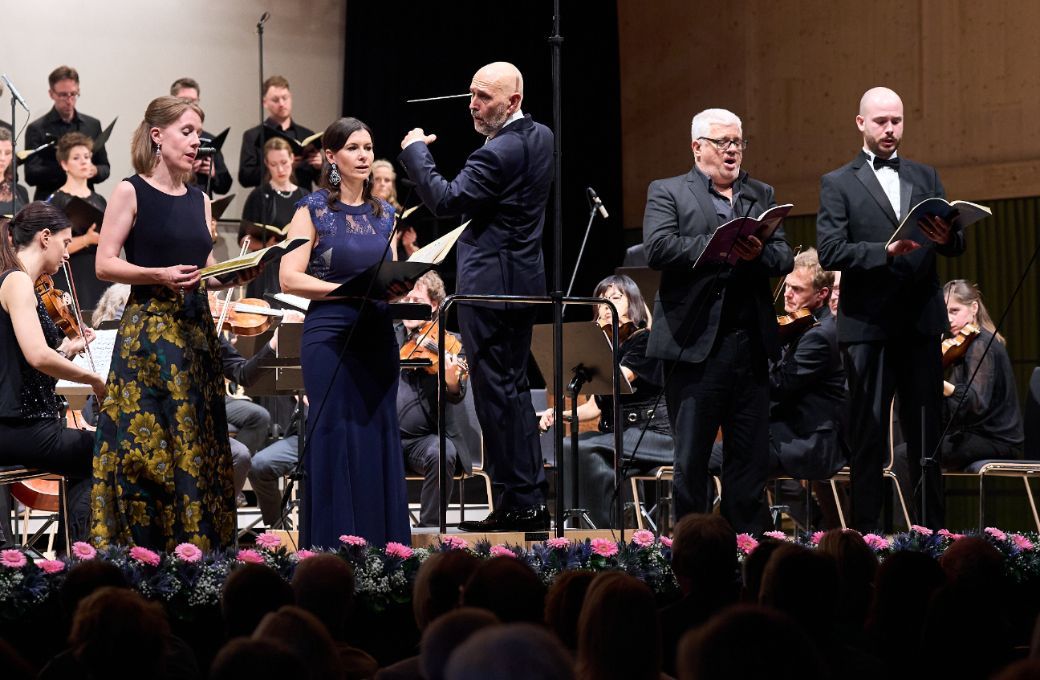This year’s Klosters Music festival began with high drama. Beethoven’s Coriolan Overture of 1807 concerns the same Coriolanus of Shakespeare’s tragedy, but opened a contemporary play by Collin. The rejected Roman general leads a band of former enemies against Rome herself, relents before the appeals of his wife and mother, then kills himself. This blend of belligerence and entreaty forms a template for themes beloved of middle-period Beethoven – we begin in C minor as fatefully as in the Fifth Symphony, and with a second lyrically pleading theme.
Enrico Onofri
© Benno Hunziker
This is overture as embryonic symphonic poem, and was given a dramatic presentation by the Munich Chamber Orchestra. For this piece they deployed a large chamber group of 34 players; pairs of woodwinds and brass, timpani, with 21 strings (6, 5, 4 ,4, 2). Modern instruments (save for pairs of natural horns and trumpets), but deployed in an historically informed manner with little use of vibrato – exactly the non-doctrinaire compromise that serves this repertoire well. So this curtain-raiser alerted those new to the Klosters Arena of its lively acoustic and solid bass (there is just empty space below the wooden platform).
This full-fat sound, so effective in the overture, was slightly less so in the ensuing Mozart Symphony no. 40 in G minor, given in its revised form with added clarinets. This much-played work has oddly never quite achieved a settled performance tradition. Schumann spoke of its “Grecian lightness and grace” and many performers play it as if handling Meissen china. But later it survived as a residual example of the mid-1780’s Sturm und Drang aesthetic deep into the Romantic era, even a tragic work. Conductor Enrico Onofri and his Munich players saw it through this 19th-century lens, helped by swift tempi and some sforzandi accents. Not everything would have satisfied the purist, especially in the Andante and Menuetto movements, but it suited this band in this hall, and followed on well from Coriolan, even sounding proto-Beethovenian at times.
Haydn’s Nelson Mass was first called “Missa in angustiis” (Mass in troubled times), reflecting Napoleon’s bullying of Austrian armies around European battlefields. When Bonaparte’s navy was defeated at the Battle of the Nile by the British fleet under Horatio Nelson, a new nickname was gained, and it has stuck. Nelson, known both for bravery and vanity, did not mind. He and Haydn, who met later on, would surely have enjoyed this evening’s terrific performance. First, we had a fine professional chorus, the 32 singers of the Zürcher Sing-Akademie, singing with fervour and power, but also precision and feeling – “miserere nobis” actually sounded lachrymose for once.
Soloists Anna Stéphany, Judith Spiesser, Werner Güra and James Atkinson
© Benno Hunziker
The choir sings in every movement of this mass, but there is much work too for the solo quartet. The soprano has by far the most to sing, and here we had a late stand-in, Judith Spiesser replacing Katharina Ruckgaber. Fortunately Spiesser is an accomplished singer of concert music, and the part was delivered with exemplary tone and accuracy, and even comfort in its higher reaches – she also sings the Queen of the Night. Mezzo-soprano Anna Stéphany was a worthy companion as ever, with her rich, warm sound. As is not always the case, close your eyes and you could not mistake which female soloist was singing. Veteran tenor Werner Güra, still producing noble tone, and British bass James Atkinson, completed a strong team. Onofri’s direction blended these vocal inputs ideally with the orchestral parts, to produce the performance of the evening. The Nelson Mass has sometimes been lauded as Haydn’s greatest single composition in any genre. Here was more support for that claim.
Roy’s press trip was funded by Klosters Music Festival.
****1
